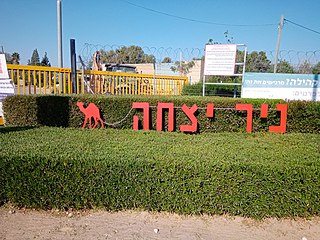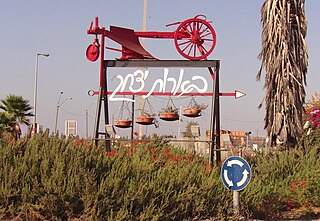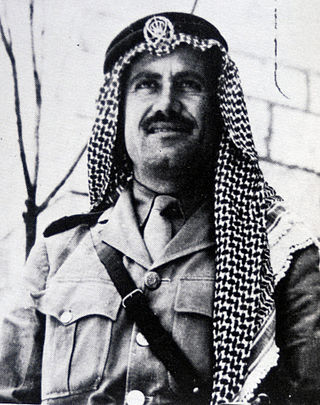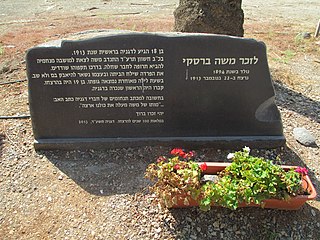Related Research Articles

Moshe Dayan was an Israeli military leader and politician. As commander of the Jerusalem front in the 1948 Arab–Israeli War, Chief of Staff of the Israel Defense Forces (1953–1958) during the 1956 Suez Crisis, but mainly as Defense Minister during the Six-Day War in 1967, he became a worldwide fighting symbol of the new state of Israel.
Meir Har-Zion was an Israeli military commando.

Gush Etzion is a cluster of Israeli settlements located in the Judaean Mountains, directly south of Jerusalem and Bethlehem in the West Bank. The core group includes four Jewish agricultural villages that were founded in 1943–1947, and destroyed by the Arab Legion before the outbreak of the 1948 Arab–Israeli War, in the Kfar Etzion massacre. The area was left outside of Israel with the 1949 armistice lines. These settlements were rebuilt after the 1967 Six-Day War, along with new communities that have expanded the area of the Etzion Bloc. As of 2011, Gush Etzion consisted of 22 settlements with a population of 70,000.

Nir Yitzhak is a kibbutz in the northwestern Negev desert of Israel. Located between Hevel Shalom and Hevel Eshkol, it falls under the jurisdiction of the Eshkol Regional Council. In 2021, it had a population of 649.

Nirim is a kibbutz in the northwestern Negev in Israel. Located near the border with the Gaza Strip, about 7 kilometres (4.3 mi) east of Khan Yunis, it falls under the jurisdiction of Eshkol Regional Council. In 2021 it had a population of 407.

Nahal Oz is a kibbutz in southern Israel. Located in the northwestern part of the Negev desert close to the border with the Gaza Strip and near the development towns of Sderot and Netivot, it is under the jurisdiction of Sha'ar HaNegev Regional Council. In 2021, it had a population of 471. A nearby IDF military base is known by the same name.

Be'erot Yitzhak is a religious kibbutz in central Israel. Located near Yehud, it falls under the jurisdiction of Hevel Modi'in Regional Council. In 2021 it had a population of 470. Kibbutz Be'erot Yitzhak was originally located in the Negev, near Gaza. In 1952, after the kibbutz was destroyed and abandoned in the Battle of Be'erot Yitzhak, it was re-established in its current location south of Petah Tivka.

Abdullah El Tell served in the Transjordanian Arab Legion during the 1948 war in Palestine rising from the rank of company commander to become Military Governor of the Old City of Jerusalem. He was later accused of being involved in the assassination of King Abdullah I−which he denied−and spent many years in Egypt before returning to Jordan in 1967.

Reprisal operations were raids carried out by the Israel Defense Forces in the 1950s and 1960s in response to frequent fedayeen attacks during which armed Arab militants infiltrated Israel from Syria, Egypt, and Jordan to carry out attacks on Israeli civilians and soldiers. Most of the reprisal operations followed raids that resulted in Israeli fatalities. The goal of these operations – from the perspective of Israeli officials – was to create deterrence and prevent future attacks. Two other factors behind the raids were restoring public morale and training newly formed army units. A number of these operations involved attacking villages and Palestinian civilians in the West Bank, including the 1953 Qibya massacre.
Events in the year 1957 in Israel.
Events in the year 1956 in Israel.

Operation Black Arrow was an Israeli military operation carried out in Gaza on 28 February 1955. The operation targeted the Egyptian Army. Thirty-eight Egyptian soldiers were killed during the operation as were eight Israelis.
The Rafah massacre occurred on November 12, 1956, during Israel's occupation of the Sinai Peninsula and Gaza Protectorate following the Suez Crisis. The town of Rafah, lying on the Egypt–Gaza border, had been one of two invasion points during the initial incursion by the Israel Defense Forces into the Strip on November 1. As with the earlier Khan Yunis massacre, circumstances surrounding the events which led to the deaths of approximately 111 residents of Rafah and the nearby refugee camp are highly disputed, with Israel neither denying nor acknowledging any wrongdoing, while admitting that a number of refugees were killed during a screening operation. Refugees, it is also claimed, continued to resist the occupying army.

Moshe Barsky was the first member of a Zionist kibbutz to be killed by an Arab.

The Netiv HaAsara massacre occurred during the 2023 Hamas attack on Israel on 7 October 2023. Thirty-five Hamas militants, some via paragliders and most via car, attacked Netiv HaAsara, an Israeli moshav close to the border fence. The militants killed at least 20 people, including in some cases members of the same family. Before the massacre, the moshav was home to approximately 900 residents.
On 7 October 2023, as part of the surprise attack on Israel, Palestinian militants from the Gaza Strip, led by Hamas, invaded the Nir Oz kibbutz in southern Israel. They killed scores of kibbutz residents, burned homes, and abducted civilians. According to the Israeli military, up to 150 militants participated in the massacre.
On 7 October 2023, a sudden assault was launched on Israel by Hamas militants originating from the Gaza Strip. They targeted Kissufim kibbutz located in the Southern District of Israel. As a result of this violent attack, at least eight kibbutz civilians and six Thai laborers were killed, and additionally at least four individuals were abducted and taken to Gaza.

The Nahal Oz attack was an assault on the kibbutz of Nahal Oz and the adjacent military base near the northern Gaza Strip on the morning of 7 October 2023 as part of a 2023 Hamas-led attack on Israel. In the attack, more than 60 Israeli soldiers and more than a dozen kibbutz residents were killed. Some soldiers and residents were kidnapped and taken to the Gaza Strip.
On 7 October 2023, a surprise assault was launched on Israel by Hamas militants coming from the Gaza Strip. One of their targets was Nirim, a kibbutz located in the southern part of Israel, about 2 kilometres (1.2 mi) from the border with Gaza. At least five kibbutz civilians died, many were injured and an unknown number of civilians were kidnapped and taken hostage to Gaza.
References
- ↑ Shalev, Chemi (20 July 2014). "Moshe Dayan's enduring Gaza eulogy: This is the fate of our generation". Haaretz.
- ↑ Kochin, Michael (2009). Five Chapters on Rhetoric, Character, Action, Things, Nothing, & Art. College Station, PA, USA: Penn State University Press. pp. 160–164. ISBN 978-0-271-03456-0.
- 1 2 3 4 5 6 7 8 9 10 Benny Morris (1993). Israel's Border Wars. Oxford University Press. pp. 393–396.
- ↑ Stein, Leslie (2014). The Making of Modern Israel; 1948-1967. John Wiley & Sons. pp. 171–172.
- ↑ Morris, Benny (2011). Righteous Victims: A History of the Zionist-Arab Conflict, 1881-1998. Knopf Doubleday Publishing Group. pp. 286–9.
- ↑ Bar-On, Mordecai (2010). Moshe Dayan: Israel's Controversial Hero. Yale University Press.
- ↑ Levitas, Gidon (1967). Naḥal: Israel's Pioneer Fighting Youth. Youth and Hechalutz Department of the World Zionist Organization. pp. 38–39.
- 1 2 3 Shapira, Anita (2012). Israel: A History. p. 271. ISBN 9781611683530 . Retrieved 23 September 2014.
- 1 2 Filiu, Jean-Pierre (2014). Gaza: A History. Oxford University Press. p. 92.
- ↑ Aloni, Udi (2011). "Samson the Non-European". Studies in Gender and Sexuality. 12 (2): 124–133. doi:10.1080/15240657.2011.559441. S2CID 143362550.
- ↑ Friedman, Matti (8 August 2012). "In the Border Kibbutz Brushed by Terror, An Understated Resilience". Times of Israel. Retrieved 14 October 2014.
- ↑ "Moshe Dayan's Eulogy for Roi Rutenberg - April 19, 1956". www.jewishvirtuallibrary.org. Retrieved 13 November 2017.